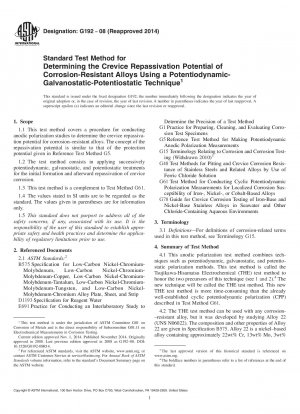ASTM G192-08(2014)
Standard Test Method for Determining the Crevice Repassivation Potential of Corrosion-Resistant Alloys Using a Potentiodynamic-Galvanostatic-Potentiostatic Technique
- Standard No.
- ASTM G192-08(2014)
- Release Date
- 2008
- Published By
- American Society for Testing and Materials (ASTM)
- Status
- Replace By
- ASTM G192-08(2020)e1
- Latest
- ASTM G192-08(2020)e1
- Scope
5.1 The THE test method is designed to provide highly reproducible crevice repassivation potentials for corrosion–resistant alloys (for example, Alloy 22) in a wide range of environments from non-aggressive to highly aggressive. In conditions of low environmental aggressiveness (such as low temperature or low chloride concentration), corrosion–resistant alloys such as Alloy 22 will resist crevice corrosion initiation and the cyclic potentiodynamic polarization test (Test Method G61) may fail to promote crevice corrosion mainly because it drives the alloy into transpassive dissolution instead of nucleating crevice corrosion. The THE test method provides a more controlled way of applying the electrical charge to the test electrode, which may induce crevice corrosion without moving it into transpassive potentials.
5.2 The more noble this crevice corrosion repassivation potential (ER,CREV) value, the more resistant the alloy is to crevice corrosion in the tested electrolyte. This is similar to other test methods to measure localized corrosion resistance such as Test Method G61 and Test Methods G48. The results from this test method are not intended to correlate in a quantitative manner with the rate of propagation that one might observe in service when localized corrosion occurs.
5.3 This test method may be used to rank several alloys by using the same testing electrolyte and temperature. It can also be used to determine the response of a given alloy when the environmental conditions (such as electrolyte composition and temperature) change.
1.1 This test method covers a procedure for conducting anodic polarization studies to determine the crevice repassivation potential for corrosion–resistant alloys. The concept of the repassivation potential is similar to that of the protection potential given in Reference Test Method G5.
1.2 The test method consists in applying successively potentiodynamic, galvanostatic, and potentiostatic treatments for the initial formation and afterward repassivation of crevice corrosion.
1.3 This test method is a complement to Test Method G61.
1.4 The values stated in SI units are to be regarded as the standard. The values given in parentheses are for information only.
1.5 This standard does not purport to address all of the safety concerns, if any, associated with its use. It is the responsibility of the user of this standard to establish appropriate safety and health practices and determine the applicability of regulatory limitations prior to use.
ASTM G192-08(2014) Referenced Document
- ASTM B575 Spec for Low-Carbon Nickel-Molydbdenum-Chromium,Low-Carbon Nickel-Chromium-Molybdenum, Low-Carbon Nickel-Chromium-Molybdenum-Copper, Low-Carbon Nickel-Chromium-Molybdenum-Tantalum, Low-Carbon Nickel-Chromium-Molybdenum-Tungsten Alloy Plate
- ASTM D1193 Standard Specification for Reagent Water
- ASTM E691 Standard Practice for Conducting an Interlaboratory Study to Determine the Precision of a Test Method
- ASTM G1 Standard Practice for Preparing, Cleaning, and Evaluating Corrosion Test Specimens
- ASTM G15 Standard Terminology Relating to Corrosion and Corrosion Testing
- ASTM G48 Standard Test Methods for Pitting and Crevice Corrosion Resistance of Stainless Steels and Related Alloys by Use of Ferric Chloride Solution
- ASTM G5 Standard Reference Test Method for Making Potentiostatic and Potentiodynamic Anodic Polarization Measurements
- ASTM G61 Standard Test Method for Conducting Cyclic Potentiodynamic Polarization Measurements for Localized Corrosion Susceptibility of Iron-, Nickel-, or Cobalt-Based Alloys*, 2024-04-20 Update
- ASTM G78 Standard Guide for Crevice Corrosion Testing of Iron-Base and Nickel-Base Stainless Alloys in Seawater and Other Chloride-Containing Aqueous Environments
ASTM G192-08(2014) history
- 2020 ASTM G192-08(2020)e1 Standard Test Method for Determining the Crevice Repassivation Potential of Corrosion-Resistant Alloys Using a Potentiodynamic-Galvanostatic-Potentiostatic Technique
- 2008 ASTM G192-08(2014) Standard Test Method for Determining the Crevice Repassivation Potential of Corrosion-Resistant Alloys Using a Potentiodynamic-Galvanostatic-Potentiostatic Technique
- 2008 ASTM G192-08 Standard Test Method for Determining the Crevice Repassivation Potential of Corrosion-Resistant Alloys Using a Potentiodynamic-Galvanostatic-Potentiostatic Technique
